In August of 2020, a 43,273-acre wildfire burned through the Joshua Tree woodland of Cima Dome. On this page, we outline the story of the Dome Fire: What caused it, the firefighters' response, its impacts on our natural and cultural resources, and what our road to recovery might look like.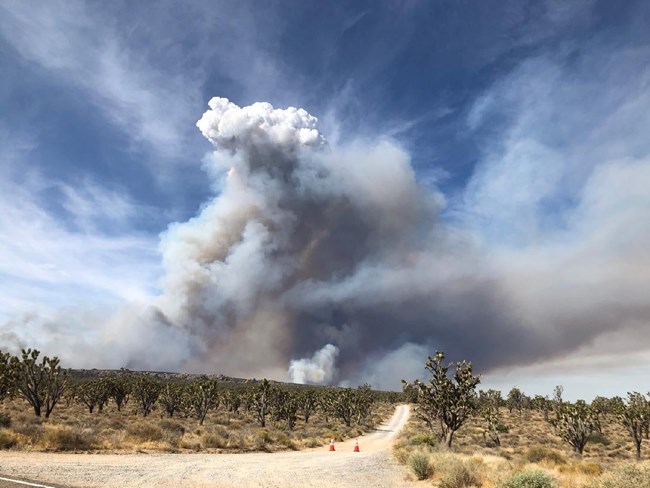
JT Sohr, NPS Initial Attack
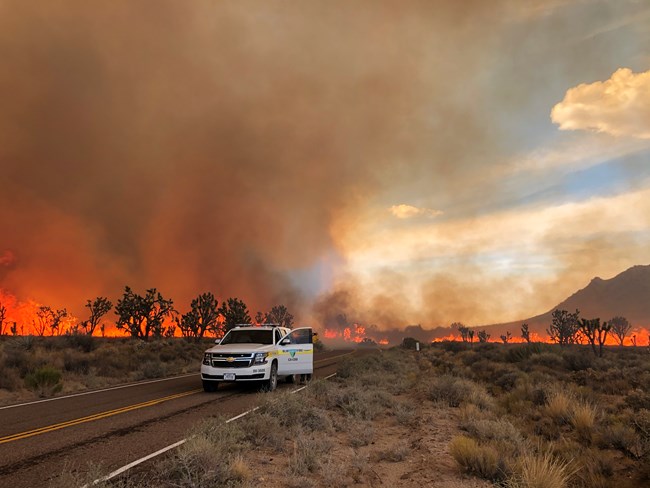
JT Sohr, NPS On the afternoon of Monday August 17, the fire's management was transferred to a Type 2 Interagency Team. The Interagency Team brought in more personell and had more ordering power for aircraft and crews needed to get the blaze under control. 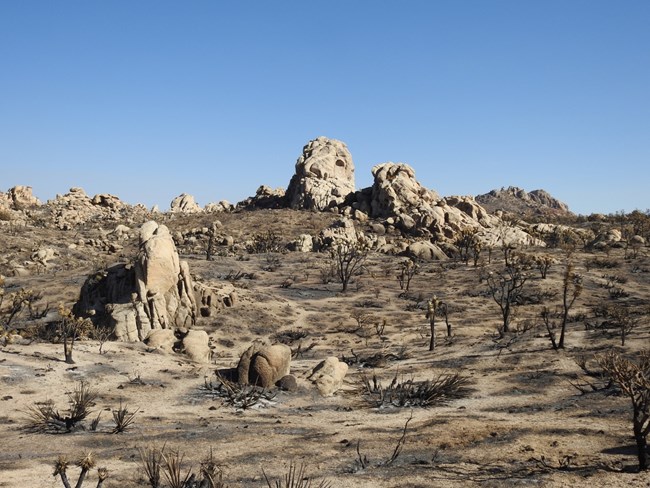
Barbara Michel, NPS Impacts on Plant LifeWhen the fire was fully contained, it had burned a total of 43,273 acres. Much of Cima Dome is now a graveyard of Joshua tree skeletons. It is estimated that as many as 1.3 million Joshua trees were killed in the fire, as well as countless cactuses, bushes, shrubs, and grasses. About 25% of the contiguous Joshua tree forest burned, which includes the portion of the forest that extends beyond the Preserve’s boundaries north of I-15. Research suggests that if the top 1/3 of Joshua trees are unburned, the plant has a chance of fire survival. However, since the Dome Fire fully scorched most of the plants it touched, it’s unlikely that many of the 1.3 million Joshua trees will recover. Although we are saddened by the loss of the Joshua trees, we are looking toward the future. The bare earth in the burn area will not be bare for long. A slow-motion battle is taking place there, invisible to human eyes. Certain plants in the area may still have surviving root reserves. With rainfall and time, they may be able to come back. Seeds of many other species are also fiercely competing for limited resources. In the coming years, some plants will live, and some will not. Unfortunately, after severe fires elsewhere in the desert southwest, invasive grasses (such as red brome, Bromus rubens) grew in thick and created a fire-grass cycle. The invasive grasses cause larger and more frequent fires by adding continuous fuels to the space between shrubs. Mojave Preserve staff are regularly monitoring the interactions between native and non-native vegetation, and we are preparing for mitigations (including direct seeding, transplanting, and herbicide application), should they become necessary. We are hopeful that native vegetation will be able to out-compete the non-natives. Impacts on Animal Life
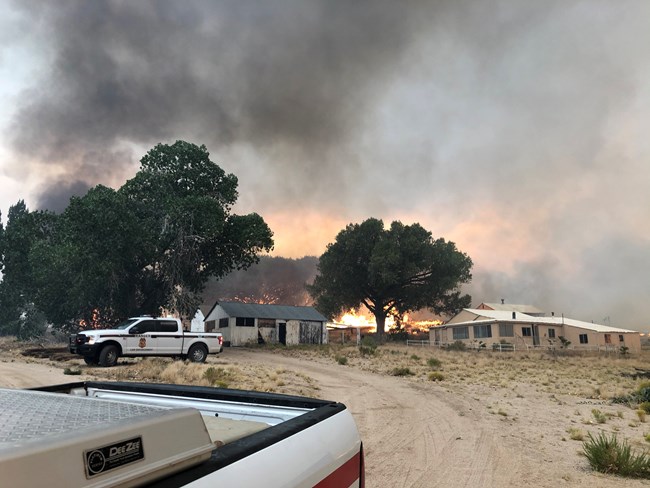
JT Sohr, NPS Impacts on Cultural ResourcesThe fire’s biggest impact on Cultural Resources is that it burned ranch buildings, water tanks and troughs, corrals, and other features that are associated with the Rock Springs Land and Cattle Company, which in the late 1800s was the second largest cattle ranching operation in California. Kessler Springs Historical Ranch House was burned, as well as historic bunkhouses both at Kessler Springs and Valley View. The main residence at Valley View Ranch was saved. Part of the corral at Cut Springs and much of the corral at White Rock Spring were lost, but the corral at Deer Springs was completely unburned. We are working with volunteer groups to restore the historical barn at Kessler Springs Ranch. Because the barn is still standing and its internal structure is known, it can be carefully restored while maintaining its appearance and historical significance. Thanks to the diligence of the firefighters and some good luck, various other treasured cultural resources (such as the Evening Star Mine) were left untouched. 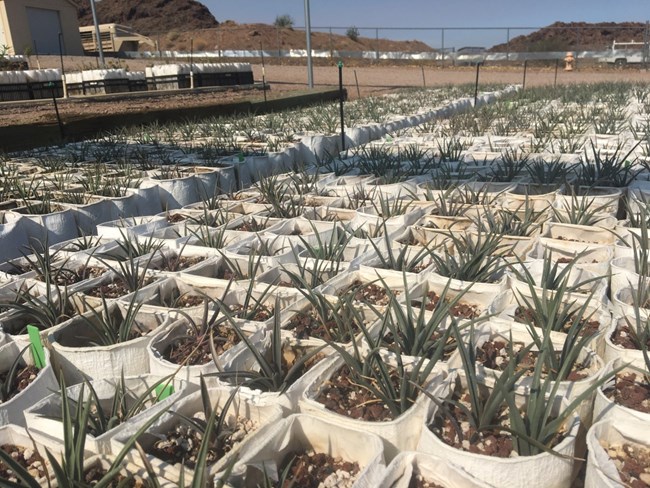
NPS What Can I Do to Help?If you’d like to help with Cima Dome’s recovery, there are a number of things you can do. First, avoid introducing weed seeds into the backcountry. Hikers and drivers on backcountry roads should make sure their shoes and vehicles are free of mud and plant debris which could harbor invasive plant seeds. Equestrians should be especially careful to follow the Preserve’s rules by feeding horses weed-free seed in the days leading up to and during their visit. Horse droppings could spread invasive seeds to areas miles from any roads that are difficult to monitor, so weed outbreaks there would be difficult to notice and mitigate. Second, be careful not to start any more fires. Though this fire was started by lightning, it could have been just as easily been started by a person. The New York Mountains and Clark Mountains have high fire potential, and the unburned parts of the Joshua tree forest could still burn, as well. Please only have fires in pre-existing fire rings, clear some defensible space, have lots of water on hand, immediately drown fires when finished and do not have a fire at all if it is windy. Third, contact us if you’re interested in volunteer opportunities. We have hundreds of Joshua trees being grown for us which we had planned to use for other projects, but now re-planting portions of the Dome Fire burn area has higher priority. We expect them to be ready for planting by winter of 2021-2022. Volunteer seed collecting trips might also be scheduled spring 2021. 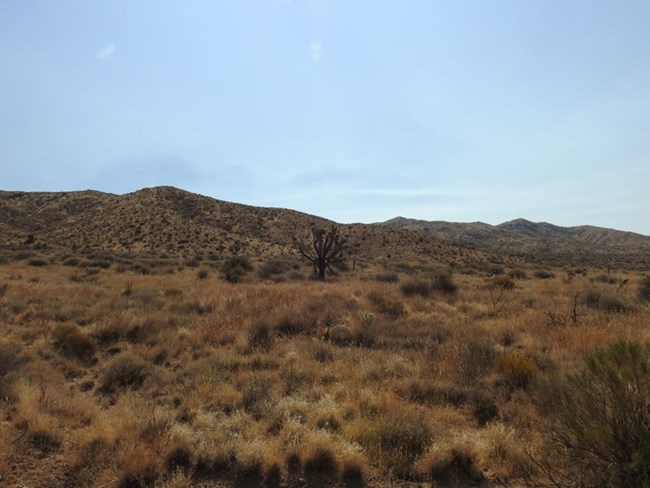
Barbara Michel, NPS Long-term PredictionsAs we look forward to the coming decades, we are optimistic that in the future Cima Dome will once again be vibrant and healthy, covered with native plant life. Our best prediction for the long-term future of the landscape is that it will transition to a Joshua tree/grassland savanna, with widely spaced out Joshua trees or Junipers and native perennial shrubs and bunchgrasses such as Big Galleta in between them. However, this will only happen if we are successful at preventing reburn of the affected area. We can find signs of success by looking to the past. The Hackberry Complex fire of 2005 burned through mostly Pinyon-Juniper forest in the Mid-Hills area, but it burned limited sections of Joshua tree forest as well. Look at the picture to the right to see the burned landscape in detail. We hope that Cima Dome follows a similar trajectory. The Joshua tree/grassland savanna is within the Cima Dome’s historic range of variability and represents a hopeful scenario for the future of the area. |
